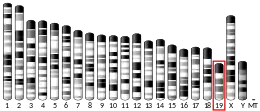Prolactin-releasing peptide receptor
The prolactin-releasing peptide receptor (PrRPR) also known as G-protein coupled receptor 10 (GPR10) is a protein that in humans is encoded by the PRLHR gene.
| PRLHR | |||||||||||||||||||||||||||||||||||||||||||||||||||
|---|---|---|---|---|---|---|---|---|---|---|---|---|---|---|---|---|---|---|---|---|---|---|---|---|---|---|---|---|---|---|---|---|---|---|---|---|---|---|---|---|---|---|---|---|---|---|---|---|---|---|---|
| Identifiers | |||||||||||||||||||||||||||||||||||||||||||||||||||
| Aliases | PRLHR, GPR10, GR3, PrRPR, prolactin releasing hormone receptor | ||||||||||||||||||||||||||||||||||||||||||||||||||
| External IDs | OMIM: 600895 MGI: 2135956 HomoloGene: 3134 GeneCards: PRLHR | ||||||||||||||||||||||||||||||||||||||||||||||||||
| |||||||||||||||||||||||||||||||||||||||||||||||||||
| |||||||||||||||||||||||||||||||||||||||||||||||||||
| |||||||||||||||||||||||||||||||||||||||||||||||||||
| |||||||||||||||||||||||||||||||||||||||||||||||||||
| |||||||||||||||||||||||||||||||||||||||||||||||||||
| Wikidata | |||||||||||||||||||||||||||||||||||||||||||||||||||
| |||||||||||||||||||||||||||||||||||||||||||||||||||
PrRPR is a G-protein coupled receptor[5] that binds the prolactin-releasing peptide (PRLH).[6]
Function
PrRPR is a 7-transmembrane domain receptor for prolactin-releasing peptide that is highly expressed in the anterior pituitary.[7]
References
- GRCh38: Ensembl release 89: ENSG00000119973 - Ensembl, May 2017
- GRCm38: Ensembl release 89: ENSMUSG00000045052 - Ensembl, May 2017
- "Human PubMed Reference:". National Center for Biotechnology Information, U.S. National Library of Medicine.
- "Mouse PubMed Reference:". National Center for Biotechnology Information, U.S. National Library of Medicine.
- Marchese A, Heiber M, Nguyen T, Heng HH, Saldivia VR, Cheng R, Murphy PM, Tsui LC, Shi X, Gregor P (1995). "Cloning and chromosomal mapping of three novel genes, GPR9, GPR10, and GPR14, encoding receptors related to interleukin 8, neuropeptide Y, and somatostatin receptors". Genomics. 29 (2): 335–44. doi:10.1006/geno.1995.9996. PMID 8666380.
- Hinuma S, Habata Y, Fujii R, Kawamata Y, Hosoya M, Fukusumi S, Kitada C, Masuo Y, Asano T, Matsumoto H, Sekiguchi M, Kurokawa T, Nishimura O, Onda H, Fujino M (1998). "A prolactin-releasing peptide in the brain". Nature. 393 (6682): 272–6. Bibcode:1998Natur.393..272H. doi:10.1038/30515. PMID 9607765. S2CID 4306854.
- "Entrez Gene: PRLHR prolactin releasing hormone receptor".
Further reading
- Hinuma S, Onda H, Fujino M (1999). "The quest for novel bioactive peptides utilizing orphan seven-transmembrane-domain receptors". J. Mol. Med. 77 (6): 495–504. doi:10.1007/s001090050403. PMID 10475064. S2CID 19633923.
- Marchese A, Heiber M, Nguyen T, et al. (1996). "Cloning and chromosomal mapping of three novel genes, GPR9, GPR10, and GPR14, encoding receptors related to interleukin 8, neuropeptide Y, and somatostatin receptors". Genomics. 29 (2): 335–44. doi:10.1006/geno.1995.9996. PMID 8666380.
- Hinuma S, Habata Y, Fujii R, et al. (1998). "A prolactin-releasing peptide in the brain". Nature. 393 (6682): 272–6. Bibcode:1998Natur.393..272H. doi:10.1038/30515. PMID 9607765. S2CID 4306854.
- Fujii R, Fukusumi S, Hosoya M, et al. (1999). "Tissue distribution of prolactin-releasing peptide (PrRP) and its receptor". Regul. Pept. 83 (1): 1–10. doi:10.1016/S0167-0115(99)00028-2. PMID 10498338. S2CID 45945978.
- Langmead CJ, Szekeres PG, Chambers JK, et al. (2000). "Characterization of the binding of [(125)I]-human prolactin releasing peptide (PrRP) to GPR10, a novel G protein coupled receptor". Br. J. Pharmacol. 131 (4): 683–8. doi:10.1038/sj.bjp.0703617. PMC 1572376. PMID 11030716.
- Lin SH, Arai AC, Wang Z, et al. (2001). "The carboxyl terminus of the prolactin-releasing peptide receptor interacts with PDZ domain proteins involved in alpha-amino-3-hydroxy-5-methylisoxazole-4-propionic acid receptor clustering". Mol. Pharmacol. 60 (5): 916–23. doi:10.1124/mol.60.5.916. PMID 11641419.
- Ozawa A, Yamada M, Satoh T, et al. (2002). "Transcriptional regulation of the human PRL-releasing peptide (PrRP) receptor gene by a dopamine 2 Receptor agonist: cloning and characterization of the human PrRP receptor gene and its promoter region". Mol. Endocrinol. 16 (4): 785–98. doi:10.1210/me.16.4.785. PMID 11923475.
- Takahashi K, Totsune K, Murakami O, et al. (2003). "Expression of prolactin-releasing peptide and its receptor in the human adrenal glands and tumor tissues of adrenocortical tumors, pheochromocytomas and neuroblastomas". Peptides. 23 (6): 1135–40. doi:10.1016/S0196-9781(02)00046-3. PMID 12126742. S2CID 24182099.
- Kemp DM, Lin JC, Ubeda M, Habener JF (2002). "NRSF/REST confers transcriptional repression of the GPR10 gene via a putative NRSE/RE-1 located in the 5' promoter region". FEBS Lett. 531 (2): 193–8. doi:10.1016/S0014-5793(02)03502-0. PMID 12417311. S2CID 31889191.
- Strausberg RL, Feingold EA, Grouse LH, et al. (2003). "Generation and initial analysis of more than 15,000 full-length human and mouse cDNA sequences". Proc. Natl. Acad. Sci. U.S.A. 99 (26): 16899–903. Bibcode:2002PNAS...9916899M. doi:10.1073/pnas.242603899. PMC 139241. PMID 12477932.
- Bhattacharyya S, Luan J, Challis B, et al. (2003). "Association of polymorphisms in GPR10, the gene encoding the prolactin-releasing peptide receptor with blood pressure, but not obesity, in a U.K. Caucasian population". Diabetes. 52 (5): 1296–9. doi:10.2337/diabetes.52.5.1296. PMID 12716769.
- Deloukas P, Earthrowl ME, Grafham DV, et al. (2004). "The DNA sequence and comparative analysis of human chromosome 10". Nature. 429 (6990): 375–81. Bibcode:2004Natur.429..375D. doi:10.1038/nature02462. PMID 15164054.
- Gerhard DS, Wagner L, Feingold EA, et al. (2004). "The status, quality, and expansion of the NIH full-length cDNA project: the Mammalian Gene Collection (MGC)". Genome Res. 14 (10B): 2121–7. doi:10.1101/gr.2596504. PMC 528928. PMID 15489334.
- Ellacott KL, Donald EL, Clarkson P, et al. (2005). "Characterization of a naturally-occurring polymorphism in the UHR-1 gene encoding the putative rat prolactin-releasing peptide receptor". Peptides. 26 (4): 675–81. doi:10.1016/j.peptides.2004.11.020. PMID 15752583. S2CID 2717651.
- Lagerström MC, Fredriksson R, Bjarnadóttir TK, et al. (2005). "Origin of the prolactin-releasing hormone (PRLH) receptors: evidence of coevolution between PRLH and a redundant neuropeptide Y receptor during vertebrate evolution". Genomics. 85 (6): 688–703. doi:10.1016/j.ygeno.2005.02.007. PMID 15885496.
- Kimura K, Wakamatsu A, Suzuki Y, et al. (2006). "Diversification of transcriptional modulation: large-scale identification and characterization of putative alternative promoters of human genes". Genome Res. 16 (1): 55–65. doi:10.1101/gr.4039406. PMC 1356129. PMID 16344560.
External links
- "Prolactin-Releasing Peptide Receptor". IUPHAR Database of Receptors and Ion Channels. International Union of Basic and Clinical Pharmacology.
- PRLHR+protein,+human at the US National Library of Medicine Medical Subject Headings (MeSH)
This article incorporates text from the United States National Library of Medicine, which is in the public domain.
This article is issued from Wikipedia. The text is licensed under Creative Commons - Attribution - Sharealike. Additional terms may apply for the media files.



